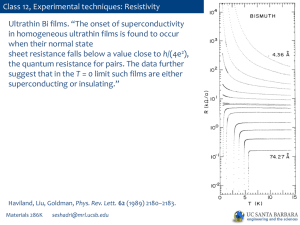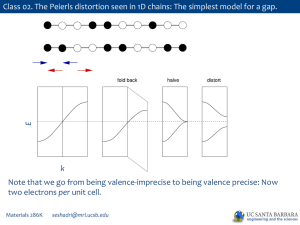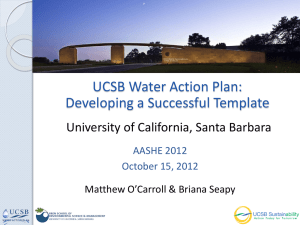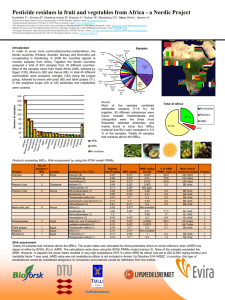PPTX
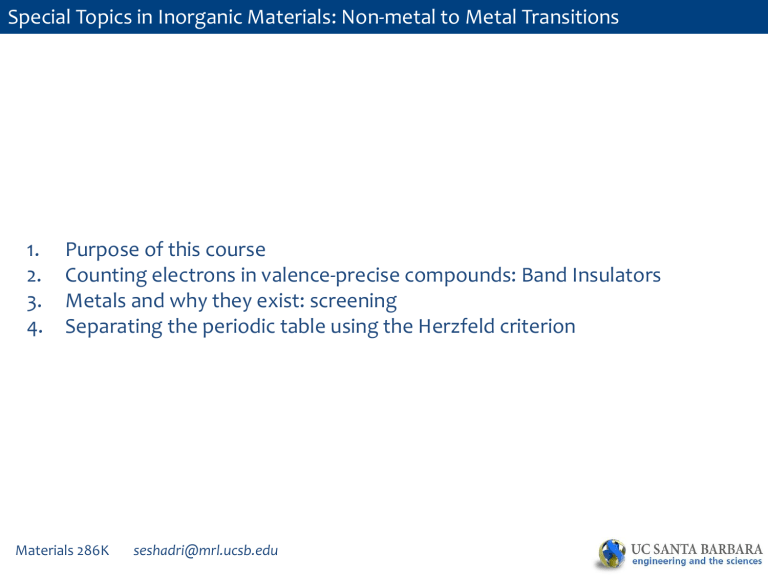
Special Topics in Inorganic Materials: Non-metal to Metal Transitions
1.
Purpose of this course
2.
Counting electrons in valence-precise compounds: Band Insulators
3.
Metals and why they exist: screening
4.
Separating the periodic table using the Herzfeld criterion
Materials 286K seshadri@mrl.ucsb.edu
Purpose of this course – understanding the diagram below:
Fujimori, Electronic structure of metallic oxides: band-gap closure and valence control, J. Phys.
Chem. Solids 53 (1992) 1595–1602.
Materials 286K seshadri@mrl.ucsb.edu
Purpose of this course – understanding the diagram below:
Fujimori, Electronic structure of metallic oxides: band-gap closure and valence control, J. Phys.
Chem. Solids 53 (1992) 1595–1602.
Materials 286K seshadri@mrl.ucsb.edu
See also: Imada, Fujimori, and Tokura, Metalinsulator transitions, Rev. Mod. Phys. 70 (1998)
1039–1263.
An example of non-metal to metal transitions: The Periodic Table
Why are most elements metallic, but not all?
Materials 286K seshadri@mrl.ucsb.edu
Another example: VO
2
6-order of magnitude resistivity change over a 10 K range in the vicinity of 340 K, in
V
0.976
Cr
0.024
O
2
Materials 286K seshadri@mrl.ucsb.edu
Marezio, McWhan, Remeika, Dernier, Structural aspects of the metal-insulator transitions in Crdoped VO
2
, Phys. Rev. B 5 (1972) 2541–2551.
Valence-precise compounds. Counting electrons in TiO
2
: Assign as Ti 4+ and O 2–
Ti d
O p
Insulator, not so easy to dope.
Materials 286K seshadri@mrl.ucsb.edu
Counting electrons in SnO
2
: Assign as Sn 4+ and O 2– (more covalent than TiO
2
)
Sn s, p
O p
Semiconductor: Easier to dope. Used as a TCO material.
Materials 286K seshadri@mrl.ucsb.edu
Counting electrons in BaPbO
3
: Assign as Pb 4+ and O 2– . An unexpected semi-metal
Pb s, p
O p
A surprise – it’s a (semi)metal. The equivalent Sn 4+ compound is not.
Materials 286K seshadri@mrl.ucsb.edu
MoS
2
: Crystal-field effects are important (and therefore structure).
It’s a semiconductor because the two d electrons occupy a (filled) d z
2 orbital.
Materials 286K seshadri@mrl.ucsb.edu
MoS
2 in the TaS
2 structure: Octahedral coordination means a metal.
The two d electrons are now in a degenerate band.
Materials 286K seshadri@mrl.ucsb.edu
Another example of crystal-field effects: PdO
Square-planar d 8 configuration allows a band insulator.
Kurzman, Miao, Seshadri, Hybrid functional electronic structure of PbPdO
2
, a small- gap semiconductor, J. Phys.: Condens. Matter 23 (2011) 465501(1–7).
Materials 286K seshadri@mrl.ucsb.edu
Metals and why they exist
The Wilson (Arthur Herries Wilson) theory:
Partially filled bands allow electrons to move, and this increases the zero-point energy (the Heisenberg uncertainty principle).
If the band were filled, the Pauli exclusion principle would ensure that any movement is precisely compensated.
However: “… overlap of the wave functions gives rise to a half-filled band, and according to the Wilson picture, the system should be metallic-however far apart the atoms might be.”
Wilson, The Theory of Metals. I, Proc. R. Soc. London. Ser. A 138 (1932) 594–606.
Quote from: Edwards and Sienko, The transition to the metallic state, Acc. Chem. Res. 15 (1982) 87–
93.
Materials 286K seshadri@mrl.ucsb.edu
Thomas-Fermi screening:
Consider the density of electrons in a metal: These are of the order of 10 22 which is as dense as a condensed (crystalline phase). If we expected these electrons to strongly repel, they should crystallize (like hard spheres do).
cm –3 ,
How is it that they go about their business like other electrons were not there.
Answer: They do NOT interact through the Coulomb (1/r) potential !
The Screened Coulomb Potential (after Kittel): k s is the Thomas-Fermi screening length:
Materials 286K seshadri@mrl.ucsb.edu
Thomas-Fermi screening: The counterintuitive role of the density of states with
The larger the densities of state, the more electrons are screened. See image below from Kittel (8 th Edn. page 407).
Also:
Materials 286K seshadri@mrl.ucsb.edu
where a
0 is the Bohr radius and n the concentration of charge
0 carriers.
is
For Cu metal, n
0 and 1/k s
= 8.5 × 10 22 cm –3
= 0.55 Å . It is only below this distance that electrons “talk”.
So more electrons in a limited volume means the less they “see” each other.
The Herzfeld criterion and the periodic table
The Clausius-Mossotti equation relates the relative dielectric e r matter to the molar refractivity R m constant of in the gaseous state, and the molar volume
V m in condensed phase.
which means that
This is the condition of a metal (infinite dielectric screening).
Since R and V are properties of the atom, this allows the periodic table to be sorted (see next page).
Edwards and Sienko, The transition to the metallic state, Acc. Chem. Res. 15 (1982) 87–93.
Materials 286K seshadri@mrl.ucsb.edu
The Herzfeld criterion and the periodic table
Edwards and Sienko, The transition to the metallic state, Acc. Chem. Res. 15 (1982) 87–93.
Materials 286K seshadri@mrl.ucsb.edu
